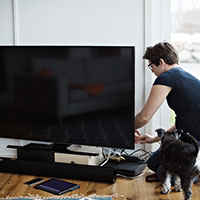Cable vs. satellite TV
Dishing out the facts to help you decide between the two television options

Television is a huge part of our world today, providing endless entertainment, information and connection. But are you tired of streaming shows on Netflix and Hulu and craving some good old-fashioned TV?
Cable and satellite are the main alternatives — they both provide a wide range of programming and additional features but vary in price, availability and reliability. Though it’s not as common in larger cities these days, satellite TV is still widely available and popular globally, offering broad coverage even in remote areas with limited infrastructure. On the other hand, cable TV might be harder to get in rural areas.
Despite competition from streaming services, both cable and satellite are affordable, accessible choices for many Americans.
Key insights
- Cable TV is common in urban and suburban areas, while satellite TV offers nationwide coverage, including in rural and remote areas.
- Cable TV offers a reliable signal transmission with limited weather interference; satellite TV may experience disruptions during severe weather conditions.
- Cable TV may provide more opportunities for local programming, but satellite TV offers a wider range of international options and access to 4K and HD content.
- Factors to consider when choosing between cable and satellite TV include affordability, availability, channel selection, technical considerations and reliability of the providers.
Cable television
Cable television has been a reliable source of entertainment for decates, offering diverse programming to households worldwide. It functions through the use of coaxial cables, which transmit signals from a central facility, usually operated by a cable provider, to individual homes and businesses via an extensive network of cables.
By connecting a cable box or using a TV with a built-in cable tuner, you can access a multitude of channels and programming.
Benefits of cable television
Cable TV is a good option if you’re in a more urban area — or if your locale is prone to bad weather.
- Easy access in urban and suburban areas: Cable television is widely available in both urban and suburban areas. Thanks to its reliable and extensive network, cable TV services are readily accessible to a large portion of the population, making it a convenient choice for many households.
- Reliable signal transmission with limited weather interference: Cable TV has a reliable signal that’s generally unaffected by weather conditions. Unlike satellite TV, which may experience disruptions during severe storms or heavy rainfall, cable TV offers a more stable viewing experience.
- Wide variety of channels and potential for local programming: Cable provides a large selection of channels, including national and international networks, premium channels and specialty programming. Many cable providers offer opportunities for local programming, allowing communities to showcase their own content and connect with their local audience.
- Bundling options for internet and phone services: Another advantage of cable TV is the availability of bundled services. Many cable providers offer package deals that combine television, internet and phone services, so you can save money and manage your entertainment and communication needs under one provider.
Drawbacks of cable television
Potential downsides of cable TV include higher costs and limited access in more rural areas.
- Limited availability in rural areas: While cable TV is broadly available in urban and suburban regions, it may have limited coverage in rural areas. The tech required for cable television networks can be costly to install and maintain, leading to less comprehensive coverage in remote or sparsely populated regions.
- Higher costs: In terms of cost, cable TV services tend to be relatively more expensive than satellite TV options. This higher price is often attributed to infrastructure investment, maintenance requirements and the extensive channel lineup offered by cable providers.
- Potential for price increases or hidden fees: Cable TV is prone to price increases over time. Providers may introduce higher rates or additional fees for certain services, equipment rentals or premium channels. It’s advisable to review the terms and conditions of cable TV subscriptions carefully to avoid any unwelcome surprises on future bills.
- Reliance on physical structures that may require maintenance: Cable TV relies on a physical structure of cables, connectors and distribution points. This may require periodic maintenance or upgrades, which can occasionally result in service disruptions. However, cable providers typically strive to minimize such inconveniences and restore services promptly.
Satellite television
Satellite TV has revolutionized the way people access and enjoy TV programming, offering a wide range of channels and exclusive content. Rather than relying on cables, it uses signals transmitted from satellites in space to deliver the content directly to your home.
With this type of TV, a satellite dish installed at your home captures the signals sent by the remote satellites. The dish then sends the signals to a receiver that decodes and converts them into the shows you see on your TV screen.
Benefits of satellite television
Satellite TV is a good choice for its affordability and wide availability, particularly for rural viewers.
- Nationwide coverage, including rural and remote areas: Satellite television offers nationwide coverage, including areas where cable infrastructure may not reach. It provides access to television programming in rural and remote regions, ensuring that viewers across the country can enjoy a wide range of channels.
- Diversity of channel options, including international programming: Satellite TV provides an extensive selection of channels, including both domestic and international programming. Viewers can access a diverse array of content, including news, sports, movies and specialty channels from countries around the world.
- Potential for high-definition (HD) and 4K content: Satellite TV systems often offer HD and even 4K content, delivering superior picture quality than standard-definition broadcasts. This gives viewers a more immersive and visually captivating watching experience.
- Competitive pricing, including budget-friendly packages: Satellite TV providers typically offer competitive pricing options, including budget-friendly packages that cater to a wide range of viewers. These packages often include a mix of popular channels and additional services so users can choose the option that best suits their needs and budget.
Possible disadvantages of satellite television
Compared with cable TV, satellite TV is a bit more vulnerable to weather disruptions, and it often has fewer options for local programming.
- Signal disruptions during severe weather conditions: Satellite TV is susceptible to signal disruptions during severe weather conditions, such as heavy rain, snowstorms or strong winds. These conditions can interfere with the satellite signals, causing temporary interruptions in the viewing experience.
- Dependence on clear line of sight to satellites: Satellite TV systems require a clear line of sight between the receiving dish and the satellite in space. Obstructions such as tall buildings, trees or unfavorable geographical terrain can obstruct the signal path, potentially affecting signal quality and reliability.
- Limited options for local programming: Unlike cable, satellite TV may have limited options for local programming. While it offers a wide range of national and international channels, local content may be harder to find because satellite providers primarily focus on broadcasting signals from a central location.
- Longer installation process: Compared with cable TV, satellite TV installations typically require more time and effort. Installing the satellite dish, properly aligning it and connecting the satellite receiver or set-top box can be a more involved process. However, professional installation services are often available to ensure a smooth setup.
How to choose between satellite and cable
Choosing between cable and satellite television requires careful consideration. Think about cost, programming availability and reliability before you make the decision.
Affordability
Both cable and satellite companies offer bundled packages for TV, internet and phone services, which can result in cost savings. Many basic Cable TV subscriptions start at about $60 per month, but you might be able to get satellite TV for closer to $30 per month (as of publishing), depending on your location.
Cable providers typically offer month-to-month payment options, while many satellite providers require a contract. You should also consider additional expenses, like equipment rental and maintenance fees.
Availability
Check the availability of cable and satellite services in your area. Research coverage and service quality to determine which option is more suitable for your needs. Satellite TV may be a good choice if you live in a rural or remote area with limited cable coverage.
Channel selection
Consider your viewing preferences and must-have channels or genres. Compare channel lineups from different providers to ensure they offer the programming you desire. Check if specific channels or content important to you are included in the packages offered by the available cable and satellite providers.
Technical considerations
Assess the reliability of signal transmission in your location and potential weather-related disruptions. Cable TV is generally less affected by weather, while satellite TV may experience temporary signal disruptions during storms. Determine if your location has a clear line of sight for satellite reception, considering potential obstructions like buildings or trees.
Residence type
Depending on the type of home you have, there may be infrastructure, restrictions and preferences that affect the viability of cable and satellite TV. Evaluate the specific factors related to your residence to determine which option is better suited for your needs.
Reliability
Consider the reputation and customer satisfaction of the cable and satellite providers you're considering. Look for reviews and ratings to gauge reliability. Assess the stability of signal transmission during adverse weather conditions, as well as any potential weather interference in your region.
FAQ
Can I watch satellite TV in an apartment building?
Yes, you can watch satellite TV in an apartment building if you have a clear view of the southern sky without obstructions. Check with your landlord for any installation guidelines or restrictions.
How can I determine the availability of cable and satellite services in my area?
To determine the availability of cable and satellite services in your area, you can start by researching and contacting local service providers. They should have tools on their websites where you can enter your address and check for service in your area.
Are there any restrictions on the number of TVs I can connect to cable or satellite TV?
Device limits may vary by service provider, but you can usually connect multiple TVs or devices.
How easy is it to switch between cable and satellite TV if I change my mind?
Switching depends on your circumstances. Contact the new provider to initiate the switch, considering contractual obligations or termination fees with your current service. A customer service rep can guide you through the process.
You’re signed up
We’ll start sending you the news you need delivered straight to you. We value your privacy. Unsubscribe easily.
